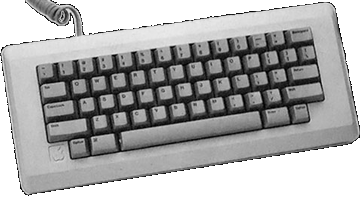Apple ][e

Essentials
Family: Pre-Macintosh
Codename: Diana
Introduced: January 1983
Terminated: March 1985
Processor
CPU: MOS Technology/SynerTek 6502
CPU Speed: 1 MHz
FPU: none
Bus Speed: 1 MHz
Register Width: 8-bit
Data Bus Width: 8-bit
Address Bus Width: 16-bit
ROM: 16 kB
Onboard RAM: 64 kB
RAM slots: expansion via 1st slot
Maximum RAM: 128 k, with Extended 80 Columns Card
Expansion Slots: 8 proprietary
Video
Max Resolution: 40/80x24 text, 4-bit 40x48, 6 color 140x192, 4-bit 140x192, 1-bit 240x192, 1-bit 560x192
Storage
Floppy Drive: optional
Input/Output
Joystick/Mouse: DE-9
Speaker: mono
Released in January 1983, The Apple ][e was to be one of the most successful Apple computers ever. It was based on the 6502 processor, which could run at 1.02 MHz. It came with 64K of RAM and a 32K ROM which included BASIC, an assembly language interface, and several other hard-coded options. The Apple ][e originally sold for $1,395, and was replaced in 1985 by an updated model. In 1984 the name was changed from Apple ][e to Apple //e, coinciding with the release of the Apple //c.
Picture Credits:
Vectronic's Apple World
Date: Wed, 05 Mar 1997 02:03:10 -0800
From: John Huber
Subject: Apple History suggestion
You should mention that the Apple IIe included the new ProDOS operating system, which was essentially a port of the Apple III's SOS. ProDOS made the IIe the easiest-to-use computer of its time.
Date: Fri, 07 Nov 1997 01:11:35 -0800
From: Neil McNeight
Subject: Apple IIe and ProDOS
On your site, it mentions that "the Apple IIe included the new ProDOS operating system". This is not entirely true. It is true that the IIe was the first Apple that was shipped with ProDOS, but the first IIe's came with the then standard of DOS 3.3. It wasn't until 1984 or so that ProDOS came around.
Date: Mon, 16 Apr 2001 23:04:17 -0700
From: Mitchell Spector
Subject: Apple IIe corrections + addition
Not long after its release, Apple came out with a new IIe motherboard (labeled Revision B) that allowed it to display Double-Hi-Res graphics and added a special video signal available to slot-7.
To display Double-Hi-Res graphics required an Extended 80 Columns Card plugged in (128 kB RAM total), as well as a Revision B or greater motherboard.
In March 1985 Apple introduced the Enhanced IIe. It was identical in every aspect to the original IIe, the only difference being four socketed chips had been changed on the motherboard: 6502, CD and EF ROMs, and the Video ROM. The 65C02 CPU added more instruction sets, the new ROM firmware fixed bugs and improved Applesoft BASIC, Monitor and 80 column routines, and finally the new Video ROM added "MouseText" characters first introduced in the IIc. Essentially the Enhancement was to make the IIe more compatible with the Apple II+ and IIc models. The original IIe (including the revision A board) could be easily user upgraded by simply swapping the 4 chips; Apple even sold an Enhancement kit upgrade.
In January 1987 Apple introduced the "Platinum IIe". Changes were mostly cosmetic and superficial, with the biggest difference being that the case color was changed from beige to the then standard platinum/grey color. Also different was a numeric keypad was built-in and the main keyboard had the same layout as the Apple IIgs and Macintosh SE. The motherboard was functionally identical to the Enhanced IIe, though the number of RAM chips making up 64 kB had been reduced (two chips instead of eight), the 16 kB ROM was merged into a single chip ("CF ROM"), and the shift-key mod was shorted to 'active' by default. Also, these IIe's shipped with 128 kB as standard (a drastically reduced version of the Extended 80 Columns Card was pre-installed in the auxiliary slot of each unit).
By 1991 Apple came out with the Apple IIe Card for the Macintosh LC series. It consisted of a PDS card with 65C02 CPU, 128 kB RAM, IWM and a Mega II chip (previously used in the Apple IIGS--the chip essentially is an entire Apple IIe on a single chip, minus RAM, CPU and ROM firmware). The Macintosh emulated Apple II video modes using QuickDraw and loaded the IIe's firmware through software. An Apple II 5.25 floppy drive and joystick could connect to the card. It could run up to 2 MHz and many slot card add-ons could be emulated by utilizing Macintosh hardware (i.e. SuperDrive, AppleTalk, serial, expanded memory, etc).
Mitch
Date: Tue, 02 Aug 2005 19:08:56 -0700
From: Antonio Rodríguez
Subject: Apple ][e
There are a couple of mistakes in the "Max Resolution" line, under the "Video" title. There are two modes referenced as 140x192 at 6 colors and 240x192 at 1 bit. Both of them have a resolution of 280x192. In fact, they are the very same video mode, displayed differently depending on what type of display (monochrome or color) is attached. With revision B boards, it was also possible a 4 bit, 80x48 mode. In fact, revision B boards had the very same videomodes as the //c.
The //e allways had a 16 Kb ROM.
